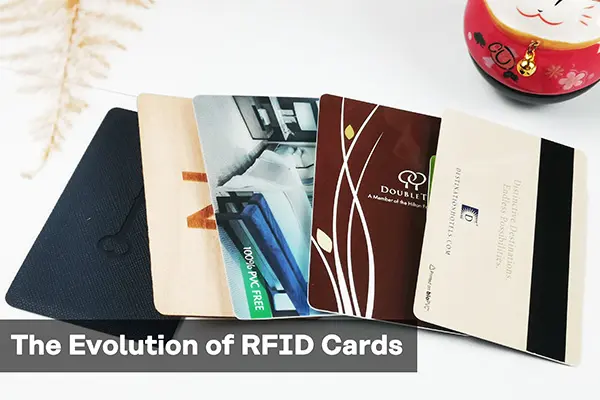The Evolution of RFID Cards
Introduction
In a world increasingly conscious of environmental impacts, the technology sector is under pressure to innovate sustainably. RFID (Radio-Frequency Identification) technology, a staple in various industries, is no exception. Traditionally, RFID cards have been made of plastic, but the shift towards eco-friendly alternatives has given rise to RFID wood cards. Let’s explore this green revolution in RFID technology.
Limitations of Plastic RFID Cards
Plastic RFID cards, while functional, have several limitations. They are non-biodegradable, contributing to long-term environmental waste. Additionally, the production and disposal of plastic involve significant carbon emissions.
The Rise of Eco-Friendly Alternatives
Growing Awareness of Environmental Issues
As awareness of environmental degradation grows, there is increasing pressure on industries to adopt sustainable practices. Consumers are more inclined to support companies that demonstrate environmental responsibility.
Demand for Sustainable Products
The demand for eco-friendly products is at an all-time high. Businesses are responding by developing sustainable alternatives to traditional products, including RFID cards.
Introduction to RFID Wood Cards
What are RFID Wood Cards?
RFID wood cards are an innovative alternative to traditional plastic cards. Made from sustainably sourced wood, these cards retain all the functionality of plastic RFID cards while being environmentally friendly.
How RFID Wood Cards Work
RFID wood cards operate the same way as their plastic counterparts. They contain an embedded microchip and antenna, which communicate with RFID readers to transmit information.

Benefits of RFID Wood Cards
-
Eco-Friendly and Sustainable
RFID wood cards are made from renewable resources, making them a more sustainable alternative to plastic cards. The use of wood reduces plastic waste and environmental pollution, aligning with the growing trend towards eco-friendly products. Additionally, many manufacturers source wood from responsibly managed forests, ensuring minimal impact on the environment.
-
Aesthetic Appeal and Customization
Wooden RFID cards offer a unique and sophisticated look that can be customized to match a brand’s identity. The natural grain and texture of wood give each card a distinctive appearance, making them ideal for premium memberships, loyalty programs, or VIP passes. Laser engraving and printing techniques allow for detailed logos and personalized designs, enhancing brand image and customer experience.
-
Durability and Longevity
Contrary to what some might think, wood cards can be highly durable. High-quality wood, combined with protective coatings, ensures that these cards can withstand everyday wear and tear. This durability extends the card’s lifespan, making it a cost-effective solution in the long run.
-
Enhanced Security Features
RFID technology embedded in wood cards offers advanced security features. These cards can store and transmit data securely, making them suitable for access control, secure identification, and contactless payments. The data can be encrypted to protect against unauthorized access, providing a high level of security for both businesses and users.
-
Versatility in Applications
RFID wood cards are versatile and can be used in various applications, including:
Access Control: For secure entry to buildings, offices, and events.
Loyalty Programs: To reward customers and enhance brand loyalty.
Hotel Key Cards: Providing an elegant and sustainable alternative to traditional plastic key cards.
Public Transportation: Enabling contactless fare collection systems.
Retail and Hospitality: For seamless payment and personalized customer experiences.

-
Improved Customer Perception
Using RFID wood cards can positively influence customer perception. The unique look and feel of wood convey a sense of exclusivity and quality. Additionally, customers who are environmentally conscious will appreciate the sustainable choice, fostering goodwill and enhancing the brand’s reputation.
-
Cost-Effective in the Long Run
While the initial cost of producing RFID wood cards may be higher than plastic cards, their extended durability and the positive impact on brand image can lead to long-term savings and increased customer loyalty. The reduced need for frequent replacements also contributes to overall cost efficiency.
-
Compatibility with Existing Systems
RFID wood cards can be easily integrated into existing RFID systems, making them a convenient upgrade for businesses looking to transition to more sustainable options without overhauling their current infrastructure. This compatibility ensures a smooth and cost-effective implementation process.
In summary, RFID wood cards combine the best of both worlds: the technological benefits of RFID and the natural appeal of wood. They offer an eco-friendly, durable, and versatile solution that can enhance security, improve customer perception, and provide long-term cost savings. As businesses and consumers continue to prioritize sustainability and innovation, the adoption of RFID wood cards is likely to grow across various sectors.

Challenges in Adopting RFID Wood Cards
Production Costs and Scalability
One of the main challenges is the higher initial cost and scalability of production. However, as demand grows and production processes improve, these costs are expected to decrease.
Consumer Perceptions and Acceptance
Changing consumer perceptions can also be challenging. Educating consumers about the benefits of wood cards and addressing any concerns about durability and performance is crucial.
Future Trends in RFID Technology
Innovations in Sustainable Materials
The future of RFID technology is likely to see more innovations in sustainable materials. Researchers are exploring other eco-friendly materials like bamboo and recycled paper for RFID cards.

Balancing Sustainability and Functionality
It’s important to balance sustainability with functionality. While eco-friendly options may sometimes come at a higher cost, the long-term environmental benefits and potential for customer goodwill can outweigh these costs.

Conclusion
The shift from plastic to wood RFID cards represents a significant step towards sustainable technology. As awareness and demand for eco-friendly products grow, innovations like RFID wood cards will become increasingly important. By choosing sustainable options, we contribute to a healthier planet while enjoying the benefits of modern technology.
Nexqo uses bamboo and FSC-certified wood for making all our wood key cards. By making informed choices and supporting sustainable products, we can play a part in promoting responsible and eco-friendly practices in the card industry,such biopvc and biopaper. Contact us , learn more about our Wooden key cards and other eco-friendly material.
.png)
